Strategic Marketing: Evaluating Segmentation, Targeting & Positioning
VerifiedAdded on 2023/06/11
|17
|4561
|264
Essay
AI Summary
This essay provides a comprehensive analysis of Segmentation, Targeting, and Positioning (STP) within strategic marketing. It begins with a literature review, highlighting the importance of STP in increasing sales, attracting new customers, and introducing new products or services. The essay then examines how companies like Apple, Zara, and Coca-Cola have successfully implemented STP strategies, focusing on market segmentation and adaptation to customer needs. Zara's zero-advertising policy and rapid supply chain are discussed as key elements of its success. The essay concludes with generic recommendations on how any company can apply STP principles to enhance its marketing efforts and achieve a competitive advantage. The document is available on Desklib, a platform offering a wealth of study resources for students.
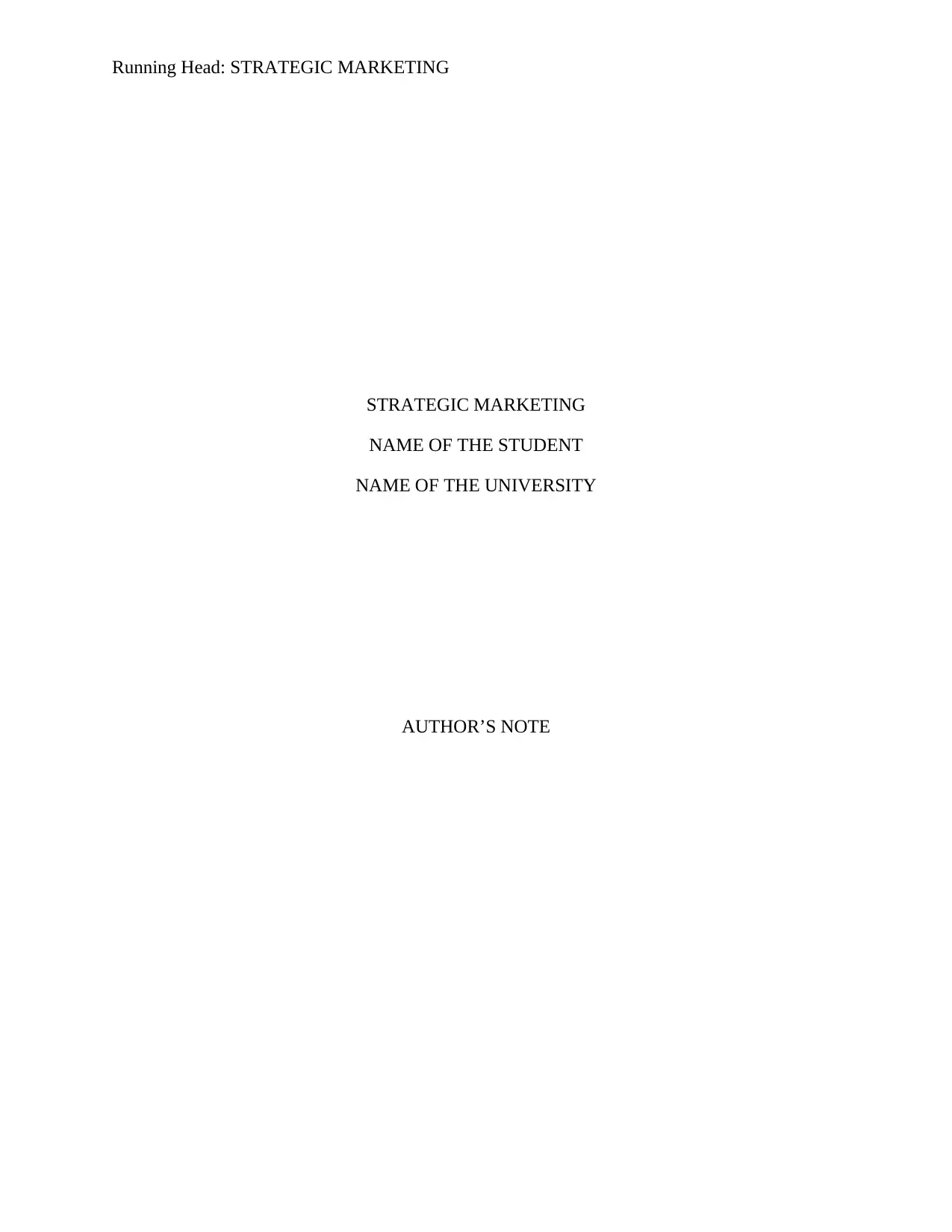
Running Head: STRATEGIC MARKETING
STRATEGIC MARKETING
NAME OF THE STUDENT
NAME OF THE UNIVERSITY
AUTHOR’S NOTE
STRATEGIC MARKETING
NAME OF THE STUDENT
NAME OF THE UNIVERSITY
AUTHOR’S NOTE
Paraphrase This Document
Need a fresh take? Get an instant paraphrase of this document with our AI Paraphraser
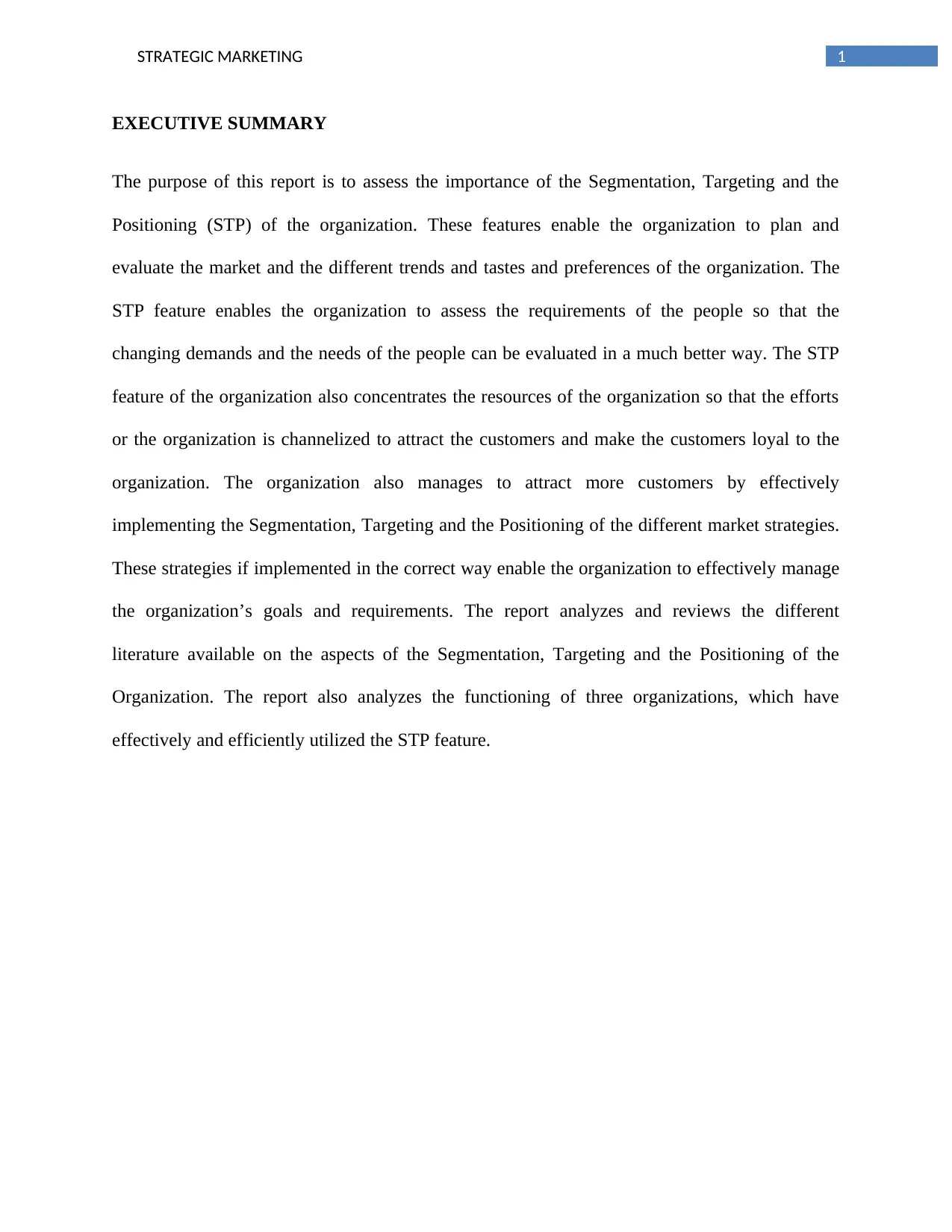
1STRATEGIC MARKETING
EXECUTIVE SUMMARY
The purpose of this report is to assess the importance of the Segmentation, Targeting and the
Positioning (STP) of the organization. These features enable the organization to plan and
evaluate the market and the different trends and tastes and preferences of the organization. The
STP feature enables the organization to assess the requirements of the people so that the
changing demands and the needs of the people can be evaluated in a much better way. The STP
feature of the organization also concentrates the resources of the organization so that the efforts
or the organization is channelized to attract the customers and make the customers loyal to the
organization. The organization also manages to attract more customers by effectively
implementing the Segmentation, Targeting and the Positioning of the different market strategies.
These strategies if implemented in the correct way enable the organization to effectively manage
the organization’s goals and requirements. The report analyzes and reviews the different
literature available on the aspects of the Segmentation, Targeting and the Positioning of the
Organization. The report also analyzes the functioning of three organizations, which have
effectively and efficiently utilized the STP feature.
EXECUTIVE SUMMARY
The purpose of this report is to assess the importance of the Segmentation, Targeting and the
Positioning (STP) of the organization. These features enable the organization to plan and
evaluate the market and the different trends and tastes and preferences of the organization. The
STP feature enables the organization to assess the requirements of the people so that the
changing demands and the needs of the people can be evaluated in a much better way. The STP
feature of the organization also concentrates the resources of the organization so that the efforts
or the organization is channelized to attract the customers and make the customers loyal to the
organization. The organization also manages to attract more customers by effectively
implementing the Segmentation, Targeting and the Positioning of the different market strategies.
These strategies if implemented in the correct way enable the organization to effectively manage
the organization’s goals and requirements. The report analyzes and reviews the different
literature available on the aspects of the Segmentation, Targeting and the Positioning of the
Organization. The report also analyzes the functioning of three organizations, which have
effectively and efficiently utilized the STP feature.
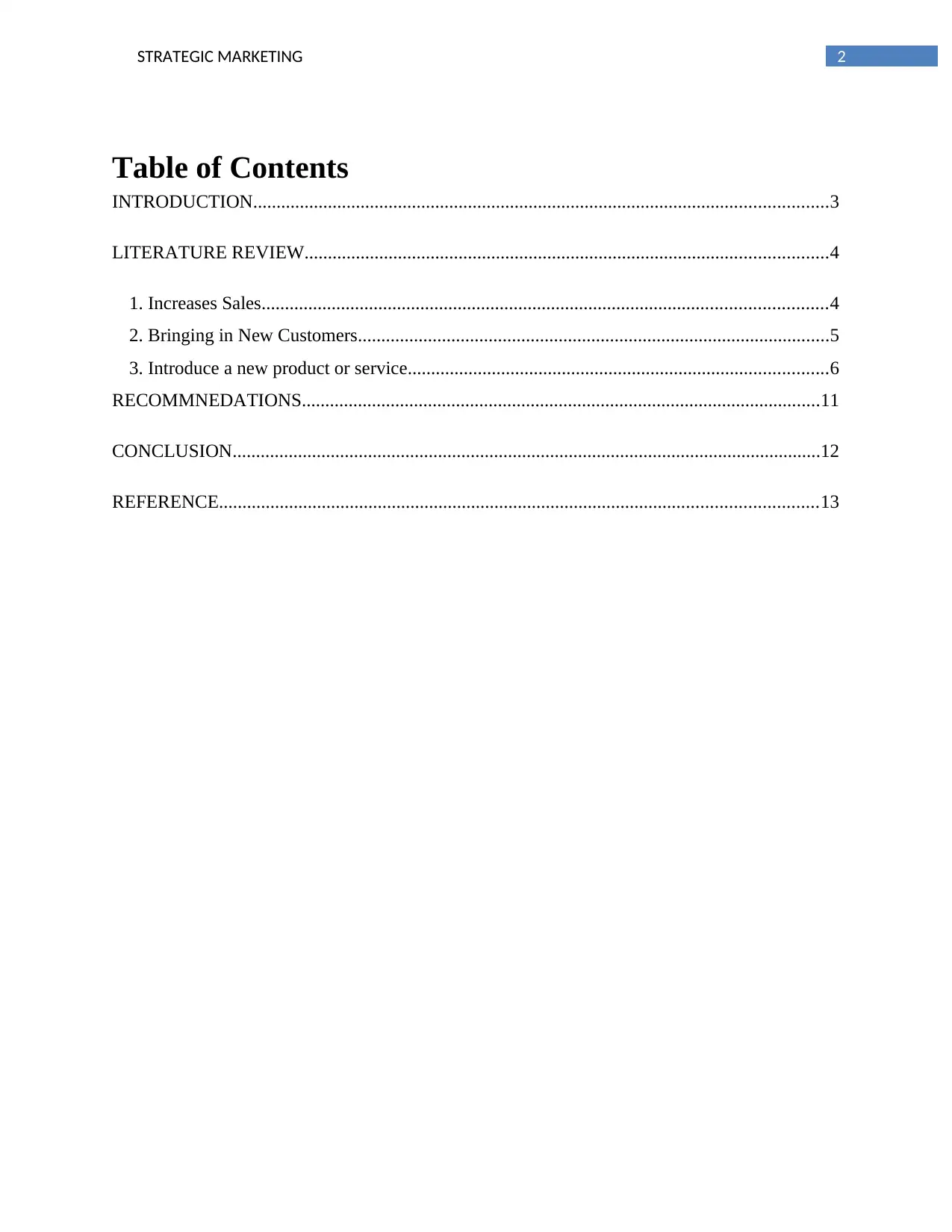
2STRATEGIC MARKETING
Table of Contents
INTRODUCTION...........................................................................................................................3
LITERATURE REVIEW................................................................................................................4
1. Increases Sales.........................................................................................................................4
2. Bringing in New Customers.....................................................................................................5
3. Introduce a new product or service..........................................................................................6
RECOMMNEDATIONS...............................................................................................................11
CONCLUSION..............................................................................................................................12
REFERENCE................................................................................................................................13
Table of Contents
INTRODUCTION...........................................................................................................................3
LITERATURE REVIEW................................................................................................................4
1. Increases Sales.........................................................................................................................4
2. Bringing in New Customers.....................................................................................................5
3. Introduce a new product or service..........................................................................................6
RECOMMNEDATIONS...............................................................................................................11
CONCLUSION..............................................................................................................................12
REFERENCE................................................................................................................................13
⊘ This is a preview!⊘
Do you want full access?
Subscribe today to unlock all pages.

Trusted by 1+ million students worldwide
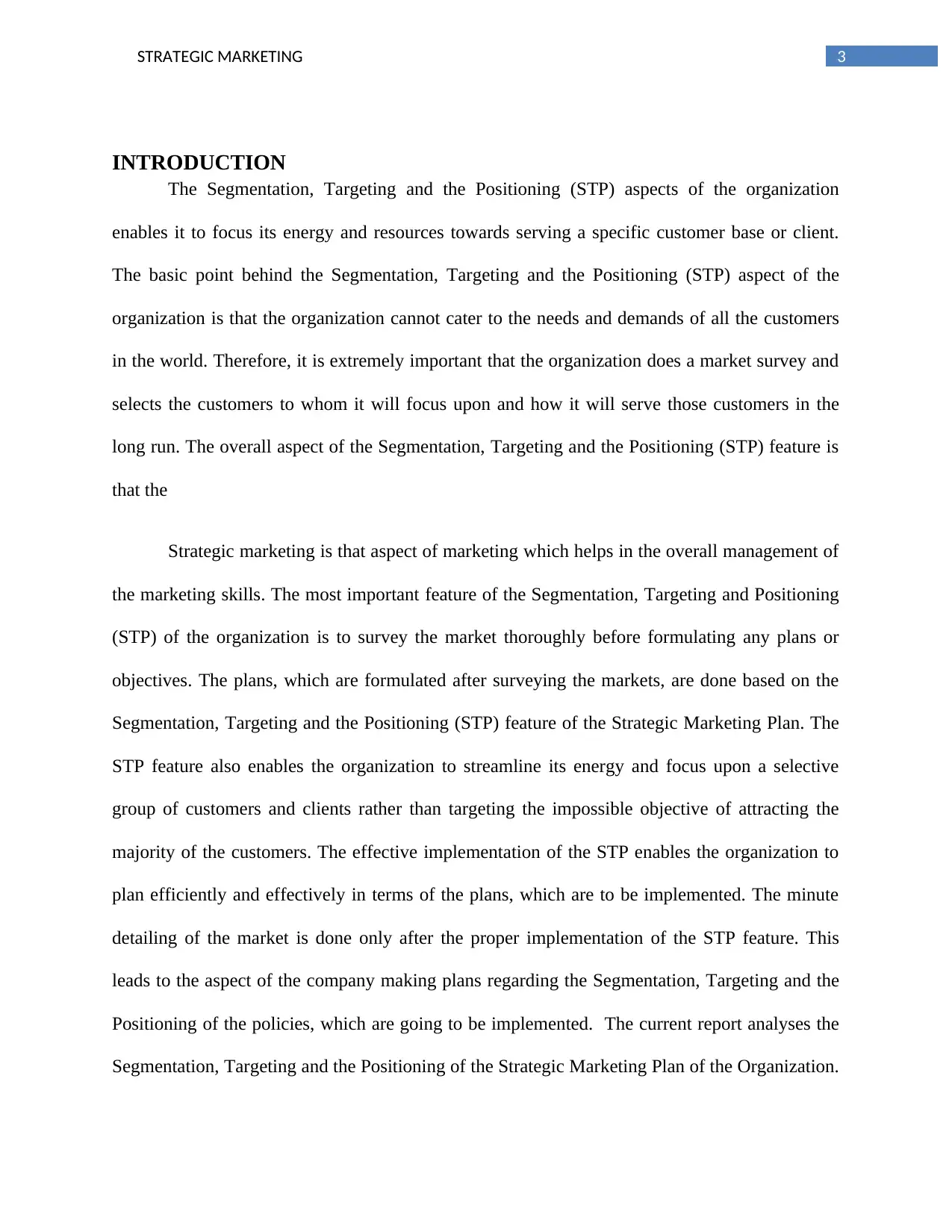
3STRATEGIC MARKETING
INTRODUCTION
The Segmentation, Targeting and the Positioning (STP) aspects of the organization
enables it to focus its energy and resources towards serving a specific customer base or client.
The basic point behind the Segmentation, Targeting and the Positioning (STP) aspect of the
organization is that the organization cannot cater to the needs and demands of all the customers
in the world. Therefore, it is extremely important that the organization does a market survey and
selects the customers to whom it will focus upon and how it will serve those customers in the
long run. The overall aspect of the Segmentation, Targeting and the Positioning (STP) feature is
that the
Strategic marketing is that aspect of marketing which helps in the overall management of
the marketing skills. The most important feature of the Segmentation, Targeting and Positioning
(STP) of the organization is to survey the market thoroughly before formulating any plans or
objectives. The plans, which are formulated after surveying the markets, are done based on the
Segmentation, Targeting and the Positioning (STP) feature of the Strategic Marketing Plan. The
STP feature also enables the organization to streamline its energy and focus upon a selective
group of customers and clients rather than targeting the impossible objective of attracting the
majority of the customers. The effective implementation of the STP enables the organization to
plan efficiently and effectively in terms of the plans, which are to be implemented. The minute
detailing of the market is done only after the proper implementation of the STP feature. This
leads to the aspect of the company making plans regarding the Segmentation, Targeting and the
Positioning of the policies, which are going to be implemented. The current report analyses the
Segmentation, Targeting and the Positioning of the Strategic Marketing Plan of the Organization.
INTRODUCTION
The Segmentation, Targeting and the Positioning (STP) aspects of the organization
enables it to focus its energy and resources towards serving a specific customer base or client.
The basic point behind the Segmentation, Targeting and the Positioning (STP) aspect of the
organization is that the organization cannot cater to the needs and demands of all the customers
in the world. Therefore, it is extremely important that the organization does a market survey and
selects the customers to whom it will focus upon and how it will serve those customers in the
long run. The overall aspect of the Segmentation, Targeting and the Positioning (STP) feature is
that the
Strategic marketing is that aspect of marketing which helps in the overall management of
the marketing skills. The most important feature of the Segmentation, Targeting and Positioning
(STP) of the organization is to survey the market thoroughly before formulating any plans or
objectives. The plans, which are formulated after surveying the markets, are done based on the
Segmentation, Targeting and the Positioning (STP) feature of the Strategic Marketing Plan. The
STP feature also enables the organization to streamline its energy and focus upon a selective
group of customers and clients rather than targeting the impossible objective of attracting the
majority of the customers. The effective implementation of the STP enables the organization to
plan efficiently and effectively in terms of the plans, which are to be implemented. The minute
detailing of the market is done only after the proper implementation of the STP feature. This
leads to the aspect of the company making plans regarding the Segmentation, Targeting and the
Positioning of the policies, which are going to be implemented. The current report analyses the
Segmentation, Targeting and the Positioning of the Strategic Marketing Plan of the Organization.
Paraphrase This Document
Need a fresh take? Get an instant paraphrase of this document with our AI Paraphraser
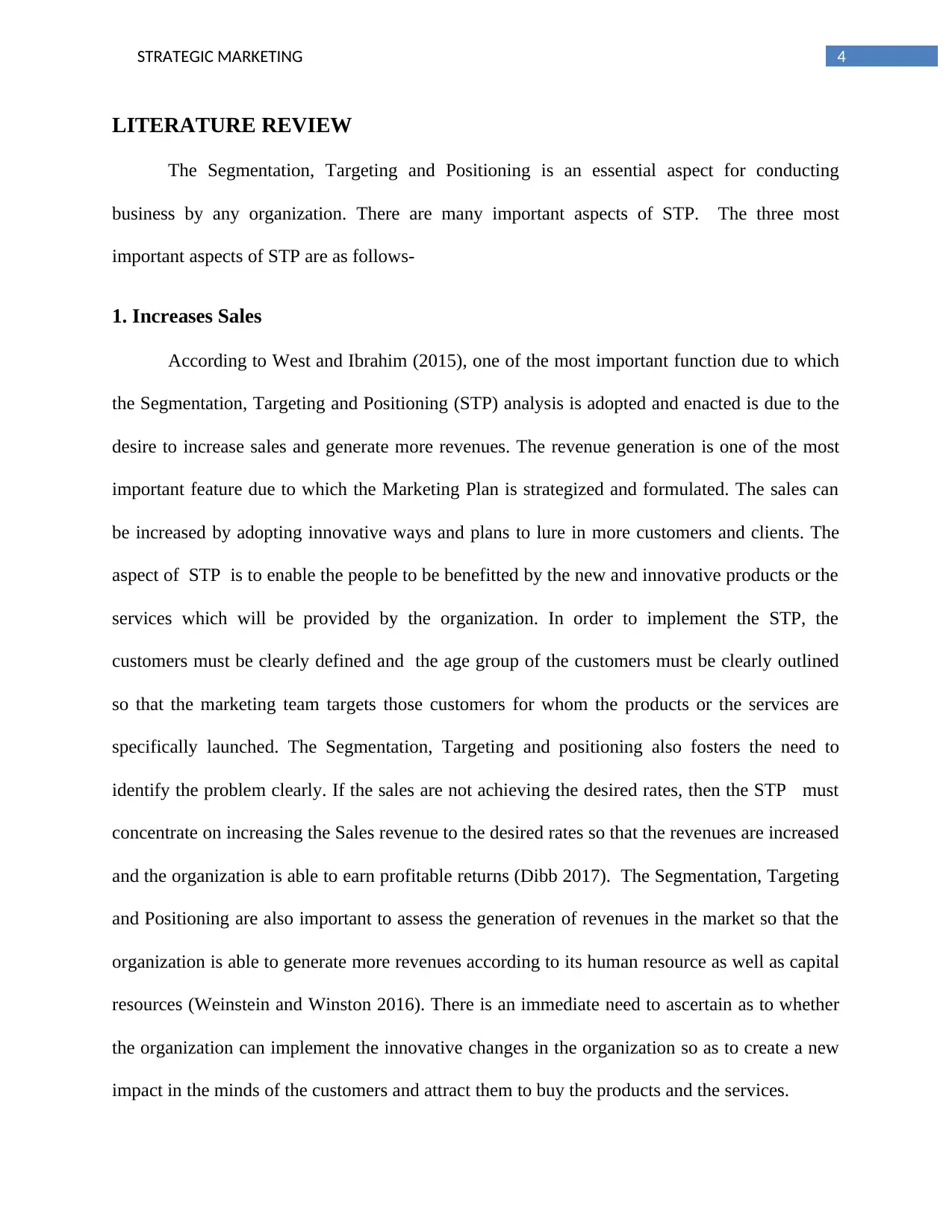
4STRATEGIC MARKETING
LITERATURE REVIEW
The Segmentation, Targeting and Positioning is an essential aspect for conducting
business by any organization. There are many important aspects of STP. The three most
important aspects of STP are as follows-
1. Increases Sales
According to West and Ibrahim (2015), one of the most important function due to which
the Segmentation, Targeting and Positioning (STP) analysis is adopted and enacted is due to the
desire to increase sales and generate more revenues. The revenue generation is one of the most
important feature due to which the Marketing Plan is strategized and formulated. The sales can
be increased by adopting innovative ways and plans to lure in more customers and clients. The
aspect of STP is to enable the people to be benefitted by the new and innovative products or the
services which will be provided by the organization. In order to implement the STP, the
customers must be clearly defined and the age group of the customers must be clearly outlined
so that the marketing team targets those customers for whom the products or the services are
specifically launched. The Segmentation, Targeting and positioning also fosters the need to
identify the problem clearly. If the sales are not achieving the desired rates, then the STP must
concentrate on increasing the Sales revenue to the desired rates so that the revenues are increased
and the organization is able to earn profitable returns (Dibb 2017). The Segmentation, Targeting
and Positioning are also important to assess the generation of revenues in the market so that the
organization is able to generate more revenues according to its human resource as well as capital
resources (Weinstein and Winston 2016). There is an immediate need to ascertain as to whether
the organization can implement the innovative changes in the organization so as to create a new
impact in the minds of the customers and attract them to buy the products and the services.
LITERATURE REVIEW
The Segmentation, Targeting and Positioning is an essential aspect for conducting
business by any organization. There are many important aspects of STP. The three most
important aspects of STP are as follows-
1. Increases Sales
According to West and Ibrahim (2015), one of the most important function due to which
the Segmentation, Targeting and Positioning (STP) analysis is adopted and enacted is due to the
desire to increase sales and generate more revenues. The revenue generation is one of the most
important feature due to which the Marketing Plan is strategized and formulated. The sales can
be increased by adopting innovative ways and plans to lure in more customers and clients. The
aspect of STP is to enable the people to be benefitted by the new and innovative products or the
services which will be provided by the organization. In order to implement the STP, the
customers must be clearly defined and the age group of the customers must be clearly outlined
so that the marketing team targets those customers for whom the products or the services are
specifically launched. The Segmentation, Targeting and positioning also fosters the need to
identify the problem clearly. If the sales are not achieving the desired rates, then the STP must
concentrate on increasing the Sales revenue to the desired rates so that the revenues are increased
and the organization is able to earn profitable returns (Dibb 2017). The Segmentation, Targeting
and Positioning are also important to assess the generation of revenues in the market so that the
organization is able to generate more revenues according to its human resource as well as capital
resources (Weinstein and Winston 2016). There is an immediate need to ascertain as to whether
the organization can implement the innovative changes in the organization so as to create a new
impact in the minds of the customers and attract them to buy the products and the services.
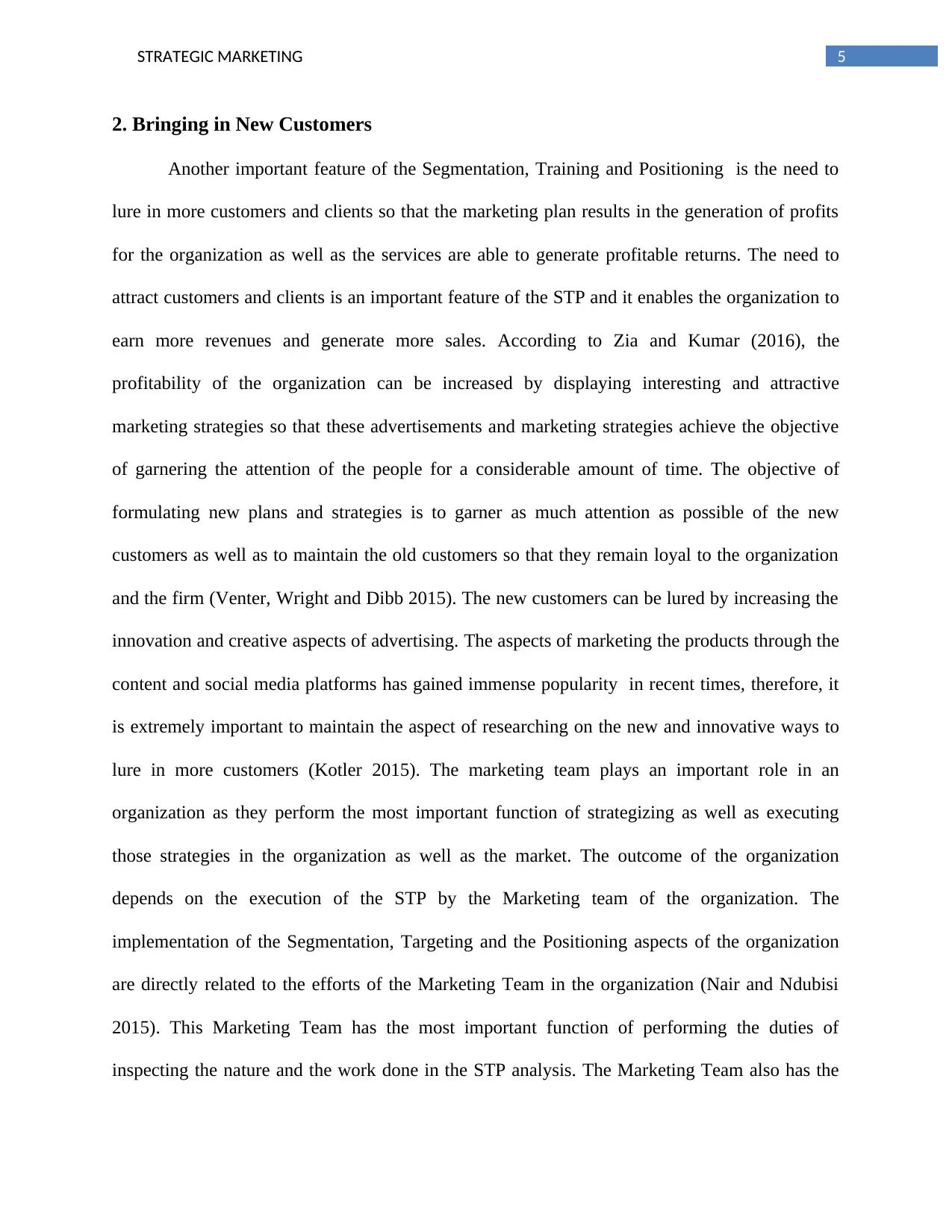
5STRATEGIC MARKETING
2. Bringing in New Customers
Another important feature of the Segmentation, Training and Positioning is the need to
lure in more customers and clients so that the marketing plan results in the generation of profits
for the organization as well as the services are able to generate profitable returns. The need to
attract customers and clients is an important feature of the STP and it enables the organization to
earn more revenues and generate more sales. According to Zia and Kumar (2016), the
profitability of the organization can be increased by displaying interesting and attractive
marketing strategies so that these advertisements and marketing strategies achieve the objective
of garnering the attention of the people for a considerable amount of time. The objective of
formulating new plans and strategies is to garner as much attention as possible of the new
customers as well as to maintain the old customers so that they remain loyal to the organization
and the firm (Venter, Wright and Dibb 2015). The new customers can be lured by increasing the
innovation and creative aspects of advertising. The aspects of marketing the products through the
content and social media platforms has gained immense popularity in recent times, therefore, it
is extremely important to maintain the aspect of researching on the new and innovative ways to
lure in more customers (Kotler 2015). The marketing team plays an important role in an
organization as they perform the most important function of strategizing as well as executing
those strategies in the organization as well as the market. The outcome of the organization
depends on the execution of the STP by the Marketing team of the organization. The
implementation of the Segmentation, Targeting and the Positioning aspects of the organization
are directly related to the efforts of the Marketing Team in the organization (Nair and Ndubisi
2015). This Marketing Team has the most important function of performing the duties of
inspecting the nature and the work done in the STP analysis. The Marketing Team also has the
2. Bringing in New Customers
Another important feature of the Segmentation, Training and Positioning is the need to
lure in more customers and clients so that the marketing plan results in the generation of profits
for the organization as well as the services are able to generate profitable returns. The need to
attract customers and clients is an important feature of the STP and it enables the organization to
earn more revenues and generate more sales. According to Zia and Kumar (2016), the
profitability of the organization can be increased by displaying interesting and attractive
marketing strategies so that these advertisements and marketing strategies achieve the objective
of garnering the attention of the people for a considerable amount of time. The objective of
formulating new plans and strategies is to garner as much attention as possible of the new
customers as well as to maintain the old customers so that they remain loyal to the organization
and the firm (Venter, Wright and Dibb 2015). The new customers can be lured by increasing the
innovation and creative aspects of advertising. The aspects of marketing the products through the
content and social media platforms has gained immense popularity in recent times, therefore, it
is extremely important to maintain the aspect of researching on the new and innovative ways to
lure in more customers (Kotler 2015). The marketing team plays an important role in an
organization as they perform the most important function of strategizing as well as executing
those strategies in the organization as well as the market. The outcome of the organization
depends on the execution of the STP by the Marketing team of the organization. The
implementation of the Segmentation, Targeting and the Positioning aspects of the organization
are directly related to the efforts of the Marketing Team in the organization (Nair and Ndubisi
2015). This Marketing Team has the most important function of performing the duties of
inspecting the nature and the work done in the STP analysis. The Marketing Team also has the
⊘ This is a preview!⊘
Do you want full access?
Subscribe today to unlock all pages.

Trusted by 1+ million students worldwide
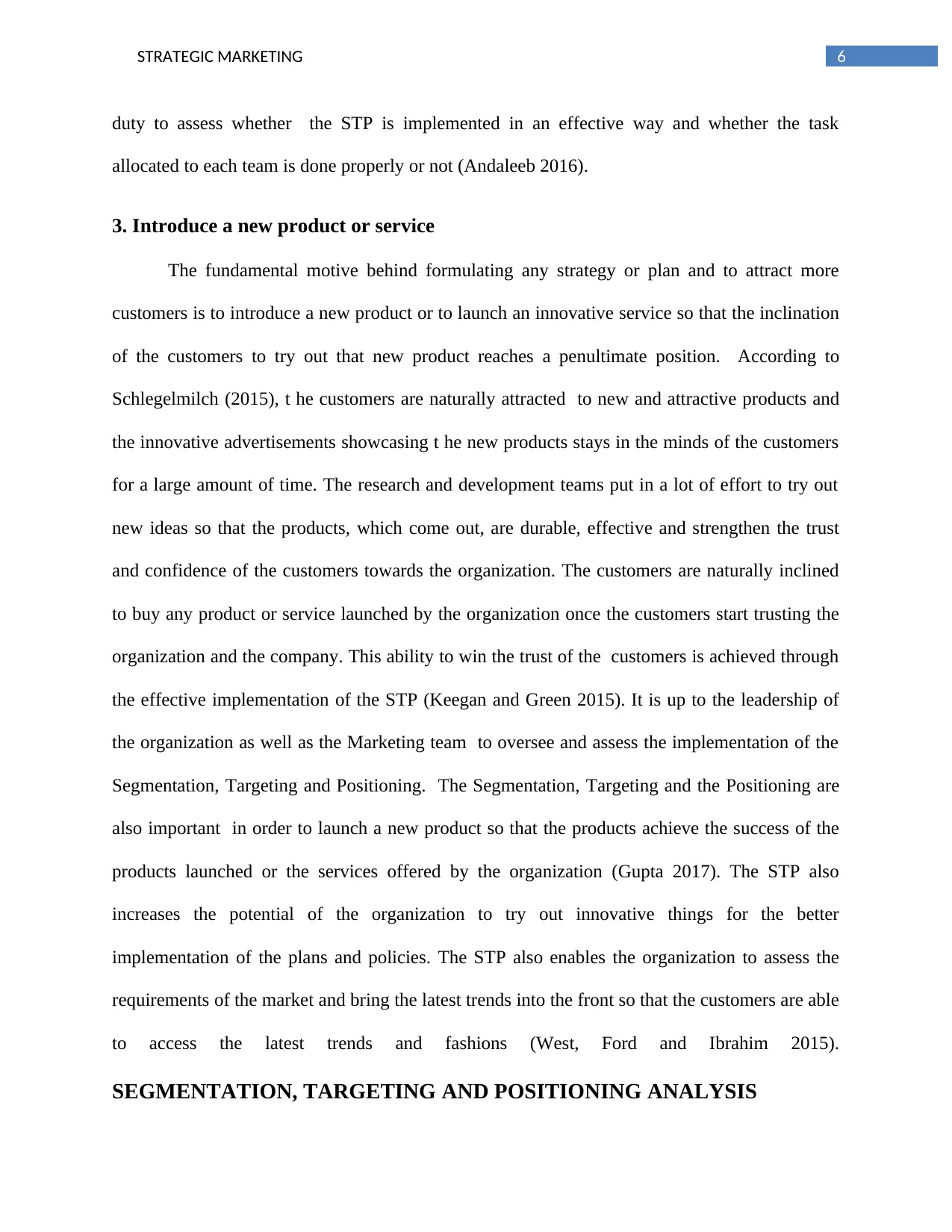
6STRATEGIC MARKETING
duty to assess whether the STP is implemented in an effective way and whether the task
allocated to each team is done properly or not (Andaleeb 2016).
3. Introduce a new product or service
The fundamental motive behind formulating any strategy or plan and to attract more
customers is to introduce a new product or to launch an innovative service so that the inclination
of the customers to try out that new product reaches a penultimate position. According to
Schlegelmilch (2015), t he customers are naturally attracted to new and attractive products and
the innovative advertisements showcasing t he new products stays in the minds of the customers
for a large amount of time. The research and development teams put in a lot of effort to try out
new ideas so that the products, which come out, are durable, effective and strengthen the trust
and confidence of the customers towards the organization. The customers are naturally inclined
to buy any product or service launched by the organization once the customers start trusting the
organization and the company. This ability to win the trust of the customers is achieved through
the effective implementation of the STP (Keegan and Green 2015). It is up to the leadership of
the organization as well as the Marketing team to oversee and assess the implementation of the
Segmentation, Targeting and Positioning. The Segmentation, Targeting and the Positioning are
also important in order to launch a new product so that the products achieve the success of the
products launched or the services offered by the organization (Gupta 2017). The STP also
increases the potential of the organization to try out innovative things for the better
implementation of the plans and policies. The STP also enables the organization to assess the
requirements of the market and bring the latest trends into the front so that the customers are able
to access the latest trends and fashions (West, Ford and Ibrahim 2015).
SEGMENTATION, TARGETING AND POSITIONING ANALYSIS
duty to assess whether the STP is implemented in an effective way and whether the task
allocated to each team is done properly or not (Andaleeb 2016).
3. Introduce a new product or service
The fundamental motive behind formulating any strategy or plan and to attract more
customers is to introduce a new product or to launch an innovative service so that the inclination
of the customers to try out that new product reaches a penultimate position. According to
Schlegelmilch (2015), t he customers are naturally attracted to new and attractive products and
the innovative advertisements showcasing t he new products stays in the minds of the customers
for a large amount of time. The research and development teams put in a lot of effort to try out
new ideas so that the products, which come out, are durable, effective and strengthen the trust
and confidence of the customers towards the organization. The customers are naturally inclined
to buy any product or service launched by the organization once the customers start trusting the
organization and the company. This ability to win the trust of the customers is achieved through
the effective implementation of the STP (Keegan and Green 2015). It is up to the leadership of
the organization as well as the Marketing team to oversee and assess the implementation of the
Segmentation, Targeting and Positioning. The Segmentation, Targeting and the Positioning are
also important in order to launch a new product so that the products achieve the success of the
products launched or the services offered by the organization (Gupta 2017). The STP also
increases the potential of the organization to try out innovative things for the better
implementation of the plans and policies. The STP also enables the organization to assess the
requirements of the market and bring the latest trends into the front so that the customers are able
to access the latest trends and fashions (West, Ford and Ibrahim 2015).
SEGMENTATION, TARGETING AND POSITIONING ANALYSIS
Paraphrase This Document
Need a fresh take? Get an instant paraphrase of this document with our AI Paraphraser
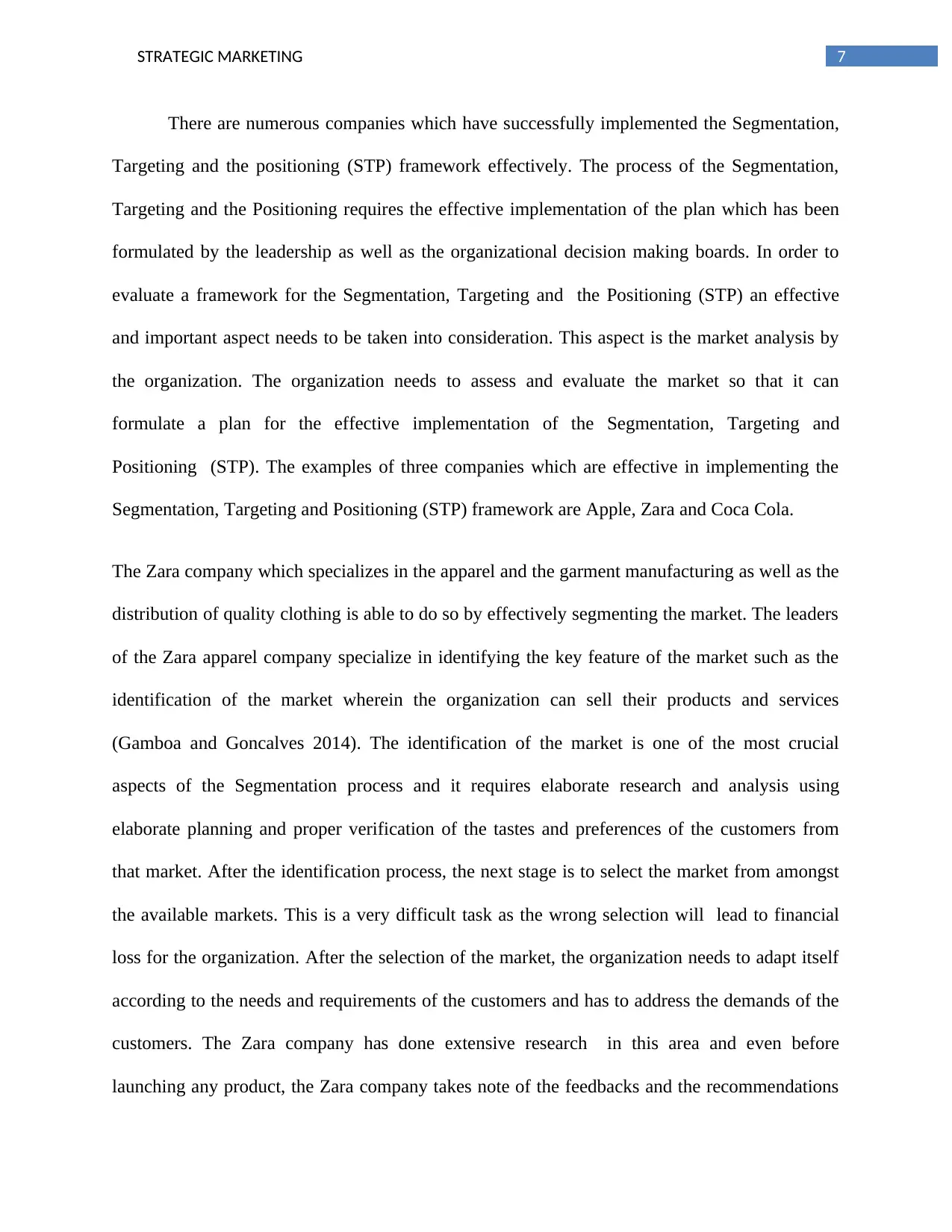
7STRATEGIC MARKETING
There are numerous companies which have successfully implemented the Segmentation,
Targeting and the positioning (STP) framework effectively. The process of the Segmentation,
Targeting and the Positioning requires the effective implementation of the plan which has been
formulated by the leadership as well as the organizational decision making boards. In order to
evaluate a framework for the Segmentation, Targeting and the Positioning (STP) an effective
and important aspect needs to be taken into consideration. This aspect is the market analysis by
the organization. The organization needs to assess and evaluate the market so that it can
formulate a plan for the effective implementation of the Segmentation, Targeting and
Positioning (STP). The examples of three companies which are effective in implementing the
Segmentation, Targeting and Positioning (STP) framework are Apple, Zara and Coca Cola.
The Zara company which specializes in the apparel and the garment manufacturing as well as the
distribution of quality clothing is able to do so by effectively segmenting the market. The leaders
of the Zara apparel company specialize in identifying the key feature of the market such as the
identification of the market wherein the organization can sell their products and services
(Gamboa and Goncalves 2014). The identification of the market is one of the most crucial
aspects of the Segmentation process and it requires elaborate research and analysis using
elaborate planning and proper verification of the tastes and preferences of the customers from
that market. After the identification process, the next stage is to select the market from amongst
the available markets. This is a very difficult task as the wrong selection will lead to financial
loss for the organization. After the selection of the market, the organization needs to adapt itself
according to the needs and requirements of the customers and has to address the demands of the
customers. The Zara company has done extensive research in this area and even before
launching any product, the Zara company takes note of the feedbacks and the recommendations
There are numerous companies which have successfully implemented the Segmentation,
Targeting and the positioning (STP) framework effectively. The process of the Segmentation,
Targeting and the Positioning requires the effective implementation of the plan which has been
formulated by the leadership as well as the organizational decision making boards. In order to
evaluate a framework for the Segmentation, Targeting and the Positioning (STP) an effective
and important aspect needs to be taken into consideration. This aspect is the market analysis by
the organization. The organization needs to assess and evaluate the market so that it can
formulate a plan for the effective implementation of the Segmentation, Targeting and
Positioning (STP). The examples of three companies which are effective in implementing the
Segmentation, Targeting and Positioning (STP) framework are Apple, Zara and Coca Cola.
The Zara company which specializes in the apparel and the garment manufacturing as well as the
distribution of quality clothing is able to do so by effectively segmenting the market. The leaders
of the Zara apparel company specialize in identifying the key feature of the market such as the
identification of the market wherein the organization can sell their products and services
(Gamboa and Goncalves 2014). The identification of the market is one of the most crucial
aspects of the Segmentation process and it requires elaborate research and analysis using
elaborate planning and proper verification of the tastes and preferences of the customers from
that market. After the identification process, the next stage is to select the market from amongst
the available markets. This is a very difficult task as the wrong selection will lead to financial
loss for the organization. After the selection of the market, the organization needs to adapt itself
according to the needs and requirements of the customers and has to address the demands of the
customers. The Zara company has done extensive research in this area and even before
launching any product, the Zara company takes note of the feedbacks and the recommendations
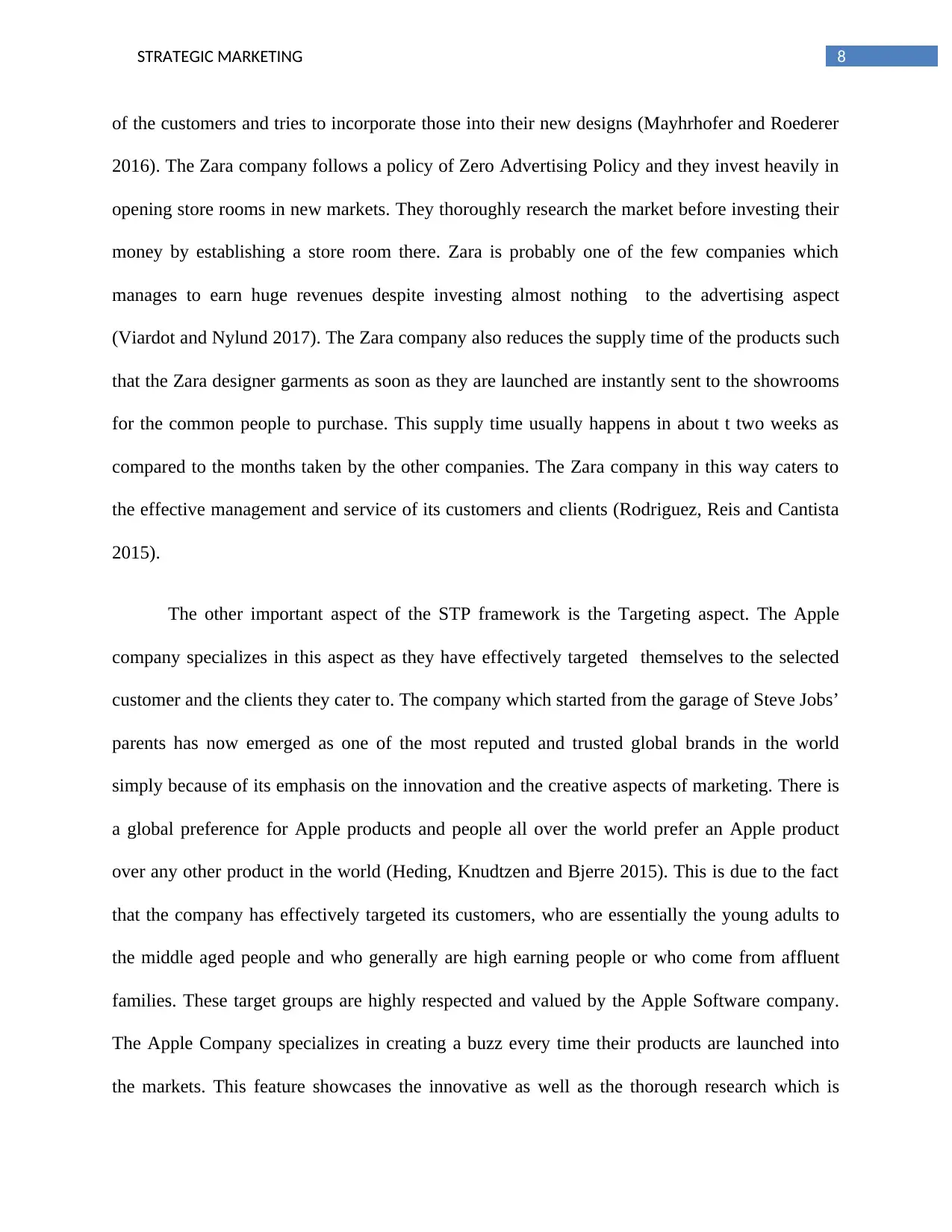
8STRATEGIC MARKETING
of the customers and tries to incorporate those into their new designs (Mayhrhofer and Roederer
2016). The Zara company follows a policy of Zero Advertising Policy and they invest heavily in
opening store rooms in new markets. They thoroughly research the market before investing their
money by establishing a store room there. Zara is probably one of the few companies which
manages to earn huge revenues despite investing almost nothing to the advertising aspect
(Viardot and Nylund 2017). The Zara company also reduces the supply time of the products such
that the Zara designer garments as soon as they are launched are instantly sent to the showrooms
for the common people to purchase. This supply time usually happens in about t two weeks as
compared to the months taken by the other companies. The Zara company in this way caters to
the effective management and service of its customers and clients (Rodriguez, Reis and Cantista
2015).
The other important aspect of the STP framework is the Targeting aspect. The Apple
company specializes in this aspect as they have effectively targeted themselves to the selected
customer and the clients they cater to. The company which started from the garage of Steve Jobs’
parents has now emerged as one of the most reputed and trusted global brands in the world
simply because of its emphasis on the innovation and the creative aspects of marketing. There is
a global preference for Apple products and people all over the world prefer an Apple product
over any other product in the world (Heding, Knudtzen and Bjerre 2015). This is due to the fact
that the company has effectively targeted its customers, who are essentially the young adults to
the middle aged people and who generally are high earning people or who come from affluent
families. These target groups are highly respected and valued by the Apple Software company.
The Apple Company specializes in creating a buzz every time their products are launched into
the markets. This feature showcases the innovative as well as the thorough research which is
of the customers and tries to incorporate those into their new designs (Mayhrhofer and Roederer
2016). The Zara company follows a policy of Zero Advertising Policy and they invest heavily in
opening store rooms in new markets. They thoroughly research the market before investing their
money by establishing a store room there. Zara is probably one of the few companies which
manages to earn huge revenues despite investing almost nothing to the advertising aspect
(Viardot and Nylund 2017). The Zara company also reduces the supply time of the products such
that the Zara designer garments as soon as they are launched are instantly sent to the showrooms
for the common people to purchase. This supply time usually happens in about t two weeks as
compared to the months taken by the other companies. The Zara company in this way caters to
the effective management and service of its customers and clients (Rodriguez, Reis and Cantista
2015).
The other important aspect of the STP framework is the Targeting aspect. The Apple
company specializes in this aspect as they have effectively targeted themselves to the selected
customer and the clients they cater to. The company which started from the garage of Steve Jobs’
parents has now emerged as one of the most reputed and trusted global brands in the world
simply because of its emphasis on the innovation and the creative aspects of marketing. There is
a global preference for Apple products and people all over the world prefer an Apple product
over any other product in the world (Heding, Knudtzen and Bjerre 2015). This is due to the fact
that the company has effectively targeted its customers, who are essentially the young adults to
the middle aged people and who generally are high earning people or who come from affluent
families. These target groups are highly respected and valued by the Apple Software company.
The Apple Company specializes in creating a buzz every time their products are launched into
the markets. This feature showcases the innovative as well as the thorough research which is
⊘ This is a preview!⊘
Do you want full access?
Subscribe today to unlock all pages.

Trusted by 1+ million students worldwide
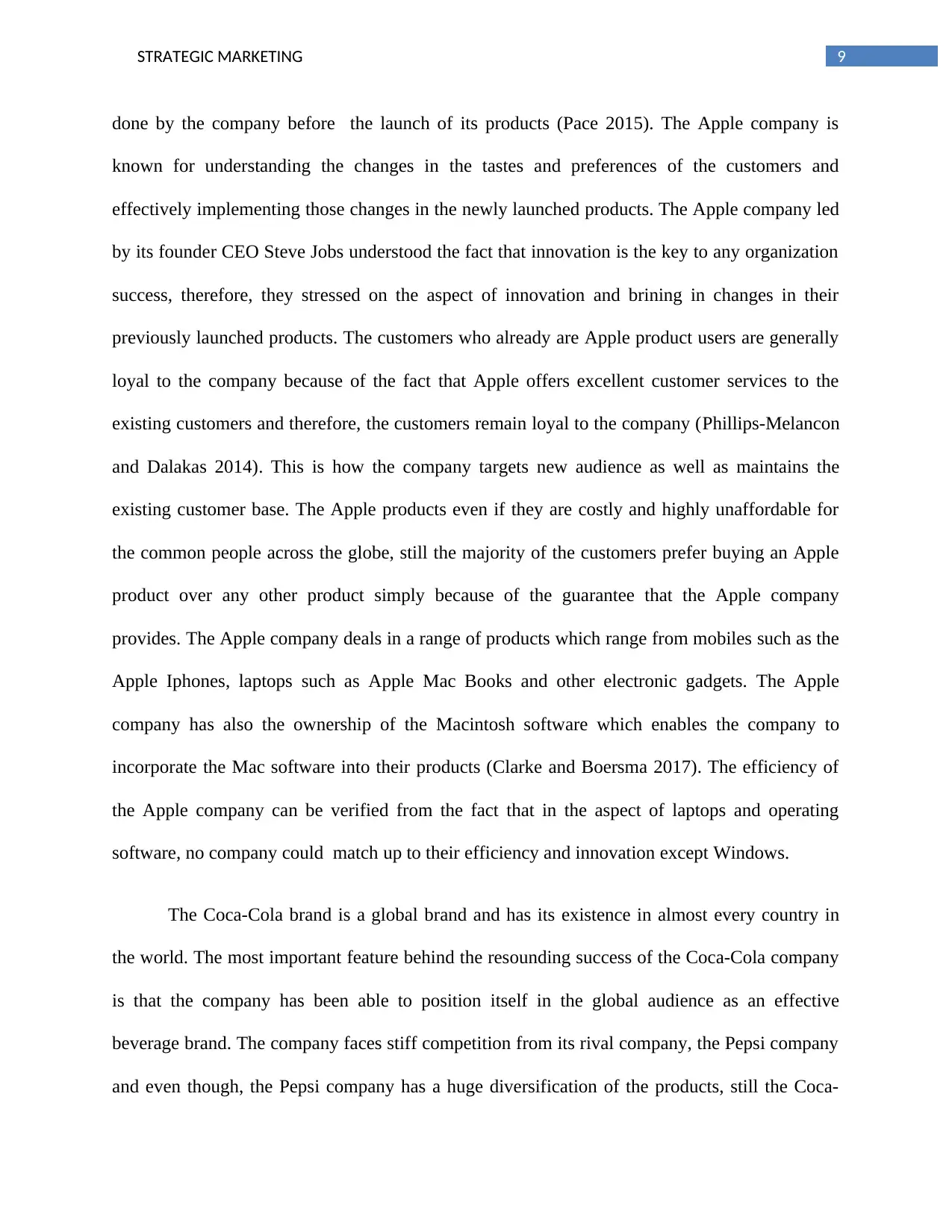
9STRATEGIC MARKETING
done by the company before the launch of its products (Pace 2015). The Apple company is
known for understanding the changes in the tastes and preferences of the customers and
effectively implementing those changes in the newly launched products. The Apple company led
by its founder CEO Steve Jobs understood the fact that innovation is the key to any organization
success, therefore, they stressed on the aspect of innovation and brining in changes in their
previously launched products. The customers who already are Apple product users are generally
loyal to the company because of the fact that Apple offers excellent customer services to the
existing customers and therefore, the customers remain loyal to the company (Phillips-Melancon
and Dalakas 2014). This is how the company targets new audience as well as maintains the
existing customer base. The Apple products even if they are costly and highly unaffordable for
the common people across the globe, still the majority of the customers prefer buying an Apple
product over any other product simply because of the guarantee that the Apple company
provides. The Apple company deals in a range of products which range from mobiles such as the
Apple Iphones, laptops such as Apple Mac Books and other electronic gadgets. The Apple
company has also the ownership of the Macintosh software which enables the company to
incorporate the Mac software into their products (Clarke and Boersma 2017). The efficiency of
the Apple company can be verified from the fact that in the aspect of laptops and operating
software, no company could match up to their efficiency and innovation except Windows.
The Coca-Cola brand is a global brand and has its existence in almost every country in
the world. The most important feature behind the resounding success of the Coca-Cola company
is that the company has been able to position itself in the global audience as an effective
beverage brand. The company faces stiff competition from its rival company, the Pepsi company
and even though, the Pepsi company has a huge diversification of the products, still the Coca-
done by the company before the launch of its products (Pace 2015). The Apple company is
known for understanding the changes in the tastes and preferences of the customers and
effectively implementing those changes in the newly launched products. The Apple company led
by its founder CEO Steve Jobs understood the fact that innovation is the key to any organization
success, therefore, they stressed on the aspect of innovation and brining in changes in their
previously launched products. The customers who already are Apple product users are generally
loyal to the company because of the fact that Apple offers excellent customer services to the
existing customers and therefore, the customers remain loyal to the company (Phillips-Melancon
and Dalakas 2014). This is how the company targets new audience as well as maintains the
existing customer base. The Apple products even if they are costly and highly unaffordable for
the common people across the globe, still the majority of the customers prefer buying an Apple
product over any other product simply because of the guarantee that the Apple company
provides. The Apple company deals in a range of products which range from mobiles such as the
Apple Iphones, laptops such as Apple Mac Books and other electronic gadgets. The Apple
company has also the ownership of the Macintosh software which enables the company to
incorporate the Mac software into their products (Clarke and Boersma 2017). The efficiency of
the Apple company can be verified from the fact that in the aspect of laptops and operating
software, no company could match up to their efficiency and innovation except Windows.
The Coca-Cola brand is a global brand and has its existence in almost every country in
the world. The most important feature behind the resounding success of the Coca-Cola company
is that the company has been able to position itself in the global audience as an effective
beverage brand. The company faces stiff competition from its rival company, the Pepsi company
and even though, the Pepsi company has a huge diversification of the products, still the Coca-
Paraphrase This Document
Need a fresh take? Get an instant paraphrase of this document with our AI Paraphraser
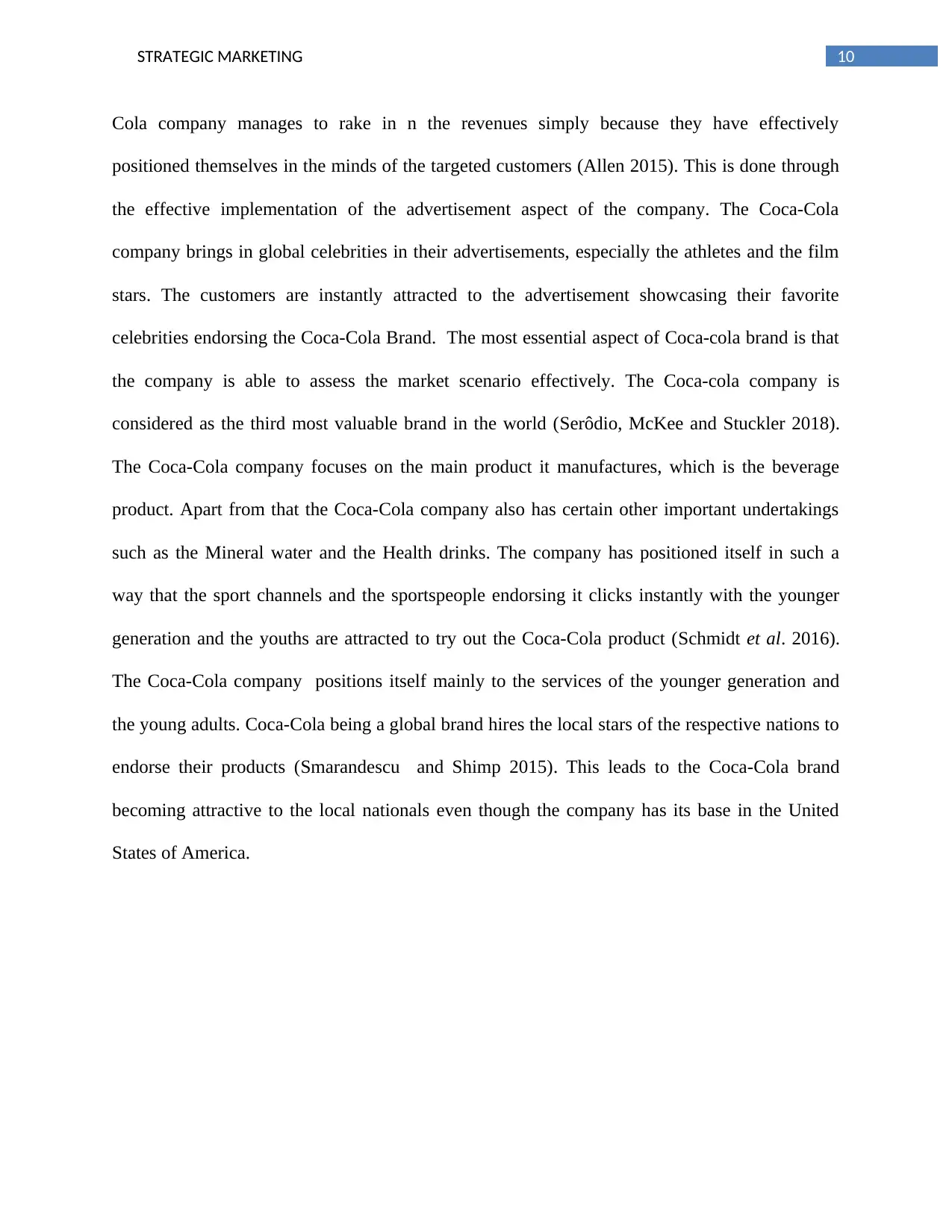
10STRATEGIC MARKETING
Cola company manages to rake in n the revenues simply because they have effectively
positioned themselves in the minds of the targeted customers (Allen 2015). This is done through
the effective implementation of the advertisement aspect of the company. The Coca-Cola
company brings in global celebrities in their advertisements, especially the athletes and the film
stars. The customers are instantly attracted to the advertisement showcasing their favorite
celebrities endorsing the Coca-Cola Brand. The most essential aspect of Coca-cola brand is that
the company is able to assess the market scenario effectively. The Coca-cola company is
considered as the third most valuable brand in the world (Serôdio, McKee and Stuckler 2018).
The Coca-Cola company focuses on the main product it manufactures, which is the beverage
product. Apart from that the Coca-Cola company also has certain other important undertakings
such as the Mineral water and the Health drinks. The company has positioned itself in such a
way that the sport channels and the sportspeople endorsing it clicks instantly with the younger
generation and the youths are attracted to try out the Coca-Cola product (Schmidt et al. 2016).
The Coca-Cola company positions itself mainly to the services of the younger generation and
the young adults. Coca-Cola being a global brand hires the local stars of the respective nations to
endorse their products (Smarandescu and Shimp 2015). This leads to the Coca-Cola brand
becoming attractive to the local nationals even though the company has its base in the United
States of America.
Cola company manages to rake in n the revenues simply because they have effectively
positioned themselves in the minds of the targeted customers (Allen 2015). This is done through
the effective implementation of the advertisement aspect of the company. The Coca-Cola
company brings in global celebrities in their advertisements, especially the athletes and the film
stars. The customers are instantly attracted to the advertisement showcasing their favorite
celebrities endorsing the Coca-Cola Brand. The most essential aspect of Coca-cola brand is that
the company is able to assess the market scenario effectively. The Coca-cola company is
considered as the third most valuable brand in the world (Serôdio, McKee and Stuckler 2018).
The Coca-Cola company focuses on the main product it manufactures, which is the beverage
product. Apart from that the Coca-Cola company also has certain other important undertakings
such as the Mineral water and the Health drinks. The company has positioned itself in such a
way that the sport channels and the sportspeople endorsing it clicks instantly with the younger
generation and the youths are attracted to try out the Coca-Cola product (Schmidt et al. 2016).
The Coca-Cola company positions itself mainly to the services of the younger generation and
the young adults. Coca-Cola being a global brand hires the local stars of the respective nations to
endorse their products (Smarandescu and Shimp 2015). This leads to the Coca-Cola brand
becoming attractive to the local nationals even though the company has its base in the United
States of America.
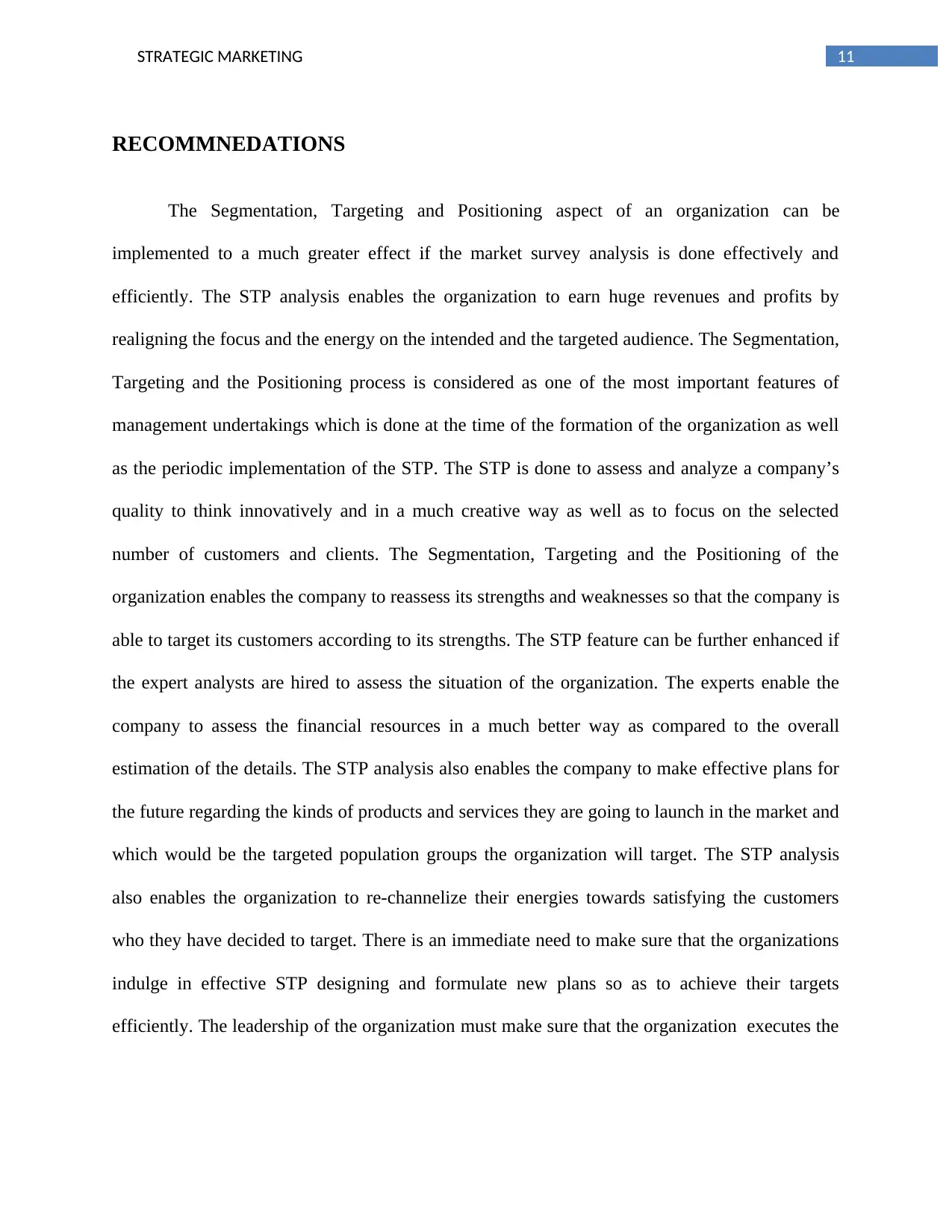
11STRATEGIC MARKETING
RECOMMNEDATIONS
The Segmentation, Targeting and Positioning aspect of an organization can be
implemented to a much greater effect if the market survey analysis is done effectively and
efficiently. The STP analysis enables the organization to earn huge revenues and profits by
realigning the focus and the energy on the intended and the targeted audience. The Segmentation,
Targeting and the Positioning process is considered as one of the most important features of
management undertakings which is done at the time of the formation of the organization as well
as the periodic implementation of the STP. The STP is done to assess and analyze a company’s
quality to think innovatively and in a much creative way as well as to focus on the selected
number of customers and clients. The Segmentation, Targeting and the Positioning of the
organization enables the company to reassess its strengths and weaknesses so that the company is
able to target its customers according to its strengths. The STP feature can be further enhanced if
the expert analysts are hired to assess the situation of the organization. The experts enable the
company to assess the financial resources in a much better way as compared to the overall
estimation of the details. The STP analysis also enables the company to make effective plans for
the future regarding the kinds of products and services they are going to launch in the market and
which would be the targeted population groups the organization will target. The STP analysis
also enables the organization to re-channelize their energies towards satisfying the customers
who they have decided to target. There is an immediate need to make sure that the organizations
indulge in effective STP designing and formulate new plans so as to achieve their targets
efficiently. The leadership of the organization must make sure that the organization executes the
RECOMMNEDATIONS
The Segmentation, Targeting and Positioning aspect of an organization can be
implemented to a much greater effect if the market survey analysis is done effectively and
efficiently. The STP analysis enables the organization to earn huge revenues and profits by
realigning the focus and the energy on the intended and the targeted audience. The Segmentation,
Targeting and the Positioning process is considered as one of the most important features of
management undertakings which is done at the time of the formation of the organization as well
as the periodic implementation of the STP. The STP is done to assess and analyze a company’s
quality to think innovatively and in a much creative way as well as to focus on the selected
number of customers and clients. The Segmentation, Targeting and the Positioning of the
organization enables the company to reassess its strengths and weaknesses so that the company is
able to target its customers according to its strengths. The STP feature can be further enhanced if
the expert analysts are hired to assess the situation of the organization. The experts enable the
company to assess the financial resources in a much better way as compared to the overall
estimation of the details. The STP analysis also enables the company to make effective plans for
the future regarding the kinds of products and services they are going to launch in the market and
which would be the targeted population groups the organization will target. The STP analysis
also enables the organization to re-channelize their energies towards satisfying the customers
who they have decided to target. There is an immediate need to make sure that the organizations
indulge in effective STP designing and formulate new plans so as to achieve their targets
efficiently. The leadership of the organization must make sure that the organization executes the
⊘ This is a preview!⊘
Do you want full access?
Subscribe today to unlock all pages.

Trusted by 1+ million students worldwide
1 out of 17
Related Documents
Your All-in-One AI-Powered Toolkit for Academic Success.
+13062052269
info@desklib.com
Available 24*7 on WhatsApp / Email
![[object Object]](/_next/static/media/star-bottom.7253800d.svg)
Unlock your academic potential
Copyright © 2020–2025 A2Z Services. All Rights Reserved. Developed and managed by ZUCOL.





